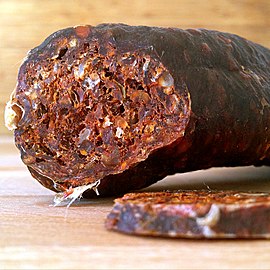|
Sujuk
Sujuk or sucuk (/suːˈd͡ʒʊk/) is a dry, spicy and fermented sausage which is consumed in several Turkish, Balkan, Middle Eastern and Central Asian cuisines. Sujuk mainly consists of ground meat and animal fat usually obtained from beef or lamb, but beef is mainly used in Turkey, Bosnia and Herzegovina, Albania, Armenia, Bulgaria, Kazakhstan, and Kyrgyzstan.[1][2][3][4] Etymology and terminologySucuk was first mentioned in the 11th century by Mahmud al-Kashgari in his Dīwān Lughāt al-Turk as suɣut. Another mention was made by Abu Hayyan al-Gharnati in his early 14th century work titled Kitab al-'idrak li-lisan al-'atrak (كتاب الإدراك للسان الأتراك). The word "suɣut" itself means "sujuk, or dried thing" and derived from Turkic root -suɣur meaning to dry or to drain off and the suffix "-çïk/-çuk" is Turkic diminutive suffix (Suɣutçuk => Sucuk).[5][6][7][8] But according to some sources, this word evolved from a Middle Iranian word attested in Early New Persian as zīç (زيچ) and ziwīdj (زویج) (meaning "stretching, strip, cord" and "sausage" respectively) which later took the form of zīçak (زیچک),[9] Cognate names are also present in other Turkic languages, e.g. Kazakh: шұжық, shujyq; Kyrgyz: чучук, chuchuk.[10][11] Franciscus a Mesgnien Meninski in his Thesaurus recorded the word sucuk (سجوق) for the first time in Ottoman Turkish in late 17th century.[5] The Turkish name sucuk has been adopted largely unmodified by other languages in the region, including: Gagauz: sucuk; Albanian: suxhuk; Arabic: سُجُق, romanized: sujuq; Armenian: սուջուխ, romanized: suǰux; Bosnian: sudžuk or sudžuka; Bulgarian: суджук, romanized: sudzhuk; Greek: σουτζούκι, romanized: sutzúki; Macedonian: суџук, romanized: sudzhuk; Azerbaijani: sucuq; Romanian: sugiuc or ghiuden; Russian: суджук, romanized: sudzhuk; Serbo-Croatian: sudžuk / cyџyк; Kurdish: benî, sicûq.[citation needed] ProductionIn Turkey, beef is the main raw material for sucuk production. At the beginning of the process the meat is preground in 14–16-millimetre (0.55–0.63 in) plates and tested for its fat content. Afterwards the meat is mixed with curing salt, which contains 0.5% sodium nitrite, and stored for 8–16 hours in 8–12 °C (46–54 °F) for further processing. Later the preground meat is mixed with frozen and ground tail fat, beef tallow, suet and additives like spices, ascorbate, dextrose and starter culture. The mixture is ground again in 1.6–5-millimetre (0.063–0.197 in) plates, which forms the mosaic structure of sucuk. Thenceforth the product is filled in casings made of collagen or fiber and these casings are twisted or tied to portionize sucuk.[12] Sucuk is then prepared for ripening process, which consists of fermentation and post-fermentation stages. In the first day of fermentation stage the product is left in a high relative humidity (RH) environment around 22–23 °C (72–73 °F). After that the RH and the temperature is gradually dropped each day, resulting to 18 °C (64 °F) and 88% RH in the last and third day of fermentation. At the end of the stage pH of the product must be dropped to 4.9–5.0. In the post-fermentation stage sucuk is matured and dried until the moisture content of the sausage is under 40%.[12]
NutritionIt was reported that sucuk from Turkey on average contained 24.5% protein, 31.5% fat, 35.65% moisture and 3.80% salt. Fat content of sucuk is highly variable; some sucuk brands tested contained only 23% fat, meanwhile others exceeded 42%.[13][14] Dishes prepared with sujukWhile sujuk can be eaten raw, it is typically cooked before consumption.[15] Thin slices of sujuk can be pan-fried in a bit of butter, while larger pieces may be grilled. Sucuklu yumurta, which literally means "eggs with sujuk", is commonly served as a Turkish breakfast dish.[16] Sucuklu yumurta is a simple dish of fried eggs cooked together with sujuk,[17] but sujuk may also be added to other egg dishes like menemen (which is similar to shakshouka but with scrambled eggs instead of poached).[18][19] Sujuk can be added to many dishes including bean stew (kuru fasulye), filled phyllo dough pastries (burek) and as a topping for pizza or pide.[20][21]
See also
References
|
||||||||||||







